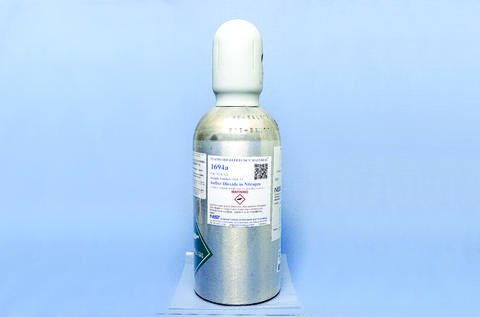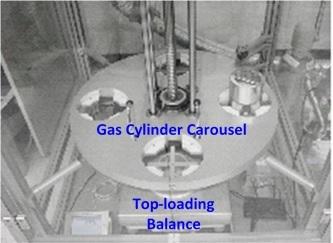Summary
Monitoring of Earth’s atmosphere for trace and greenhouse gases relies upon a system of high accuracy gas concentration standards. Greenhouse gases concentration standards disseminated by NOAA, recognized worldwide, and linked to the International System of Units by NIST form the basis for effective comparison of atmospheric observing data taken at observatories globally. NIST works in close collaboration with NOAA to ensure the integrity and accuracy of these widely-used standards.
Description

SRM 1694a sulfur dioxide in nitrogen
NIST develops suites of SI-traceable, amount-of-substance, primary gas standard mixtures (PSMs) for key trace and greenhouse gas species to provide traceability to the International System of Units for a range of user communities. Standard Reference Materials (SRMs), certified to the PSMs, are developed and disseminated to researchers and scientist to achieve consistency in their atmospheric measurements through SI traceability.
For the greenhouse gases, the requirements represented by the Data Quality Objectives (DQO) for monitoring of the global atmosphere set by the World Meteorological Organization’s (WMO) Global Atmospheric Watch (GAW) are an important user community need.
WMO Data Quality Objectives for key Greenhouse Gases
|
GHG |
Data Quality Objective |
|---|---|
|
Carbon Dioxide |
± 0.1 µmol/mol (390 µmol/mol) |
|
Methane |
± 2 nmol/mol (1840 nmol/mol) |
|
Nitrous Oxide |
± 0.1 nmol/mol (325 nmol/mol) |
|
Carbon Monoxide |
±2 nmol/mol (150 nmol/mol) |
NIST has recently developed new standards that provide uncertainties that are equivalent to, or lower than, on a relative basis, the WMO DQO requirements when considering all sources of error. These SRMs required that NIST develop a new suite of gravimetric primary gas mixtures linked to the SI, through the kilogram. The resulting uncertainties are an order-of-magnitude smaller than achieved previously. The purity and isotopic composition of starting materials were determined with unprecedented sensitivity, demanding a variety of new methods and analyses, and extensive scrutiny of the experimental results.
Substantially improved mass measurements also were necessary, which required the use of advanced, automated, high-precision mass balances. Previous mass weighing’s were made manually which required hands-on time and added significant uncertainty to the results. Using enclosed and automated weighing systems, the group realized high-precision mass determinations with tenfold lower uncertainties. Also, the SRM gases were obtained by sampling in remote locations (Niwot Ridge, Colorado in collaboration with NOAA’s Global Monitoring Division and Baring Head, New Zealand) where pristine samples of the atmosphere could be acquired. On-site visits to these remote sampling sites were performed and sampling procedures were scrutinized by NIST staff.
In all respects, the work was far from routine and clearly advanced the state-of-the-art. It should be noted that this work addressed development of the suites of methane and nitrous oxide primary standards, technical challenges caused by interactions of carbon dioxide with gas cylinder walls, investigation of the methane historical record and descriptions of the resulting Northern Continental (SRM 1720) and Southern Hemisphere (SRM 1721) gas standards.

WMO’s data quality objectives are baseline values used globally by the atmospheric greenhouse gas measurement community to report measurements reported to the WMO and are the basis for comparison among data sets obtained from the observing stations of GAW’s global monitoring network. This network has been established and is supported by many nations. The consistency of these data is achieved largely through linkage of observing protocols and concentration (amount of substance) standards for CO2, CH4, and N2O. These greenhouse gas concentration scales are established and disseminated by NOAA’s Earth System Research Laboratory, Global Monitoring Division (GMD) acting as WMO’s Central Calibration Laboratory for dioxide (CO2), methane (CH4), and nitrous oxide (N2O). Observations of greenhouse gas concentrations made by the U.S. and other nations are primary data products providing information about change in concentrations of greenhouse and other trace gases in the global atmosphere. NIST collaborates closely with GMD to provide linkage to the International System of Units (the SI), as the final step in bolstering international recognition of these data sets.
Major Accomplishments
- Developed CH4 in dry whole air suite of ambient level PSMs with a combined uncertainty of < 0.04 % relative uncertainty in PSMs
- Developed CO2 in dry whole air suite of ambient level PSMs with a combined uncertainty of < 0.03 % relative uncertainty in PSMs
- Developed N2O in synthetic air (O2/N2)suite of ambient level PSMs with a combined uncertainty of < 0.03 % relative uncertainty in PSMs
- Developed N2O in synthetic air (Ar/O2/N2)suite of ambient level PSMs with a combined uncertainty of < 0.03 % relative uncertainty in PSMs
- Participated in ambient level CH4 in air CCQM key comparison K-82. NIST results were within 2 nmol/mol of key comparison reference value and were within the uncertainty bounds of the key comparison reference value.
Associated Publications
- Jeerage, K. M., Berry, J. L., Murray, J. A., Goodman, C. A., Piotrowski, P. K., Jones, C. M., Cecelski, C. E., Carney, J., Lippa, K. A., and Lovestead, T. M., "The need for multicomponent gas standards for breath biomarker analysis," Journal of Breath Research, 16, (2022).
- Srivastava, A., Long, S. E., Norris, J. E., Bryan, C. E., Carney, J., and Hodges, J. T., "Comparison of Primary Laser Spectroscopy and Mass Spectrometry Methods for Measuring Mass Concentration of Gaseous Elemental Mercury," Analytical Chemistry, 93, 1050-1058 (2021).
- Long, S. E., Norris, J. E., Carney, J., and Ryan, J. V., "Provision of primary NIST traceability to support vapor phase mercury emissions monitoring of combustion sources using isotope dilution inductively coupled plasma mass spectrometry," Atmospheric Pollution Research, 11, 909-919 (2020).
- Viallon, J., Flores, E., Idrees, F., Moussay, P., Wielgosz, R. I., Oh, S. H., Lee, S., Kim, B. M., Nieuwenkamp, G., Van der Veen, A., Efremova, O. V., Konopelko, L. A., Kustikov, Y. A., Kolobova, A. V., Shuguo, H., Carney, J., Kelley, M. E., Rhoderick, G. C., Hodges, J. T., Uehara, S., Akima, D., Brewer, P., Worton, D., Van Aswegen, S., Mace, T., Smeulders, D., Fuko, J., Ntsasa, N., Leshabane, N., Ramahala, K., Tshilongo, J., Cieciora, D., Shimosaka, T., and Matsumoto, N., "CCQM-K137, nitrogen monoxide (NO) in nitrogen," Metrologia, 57, (2020).
- Rhoderick, G. C., Cecelski, C. E., Miller, W. R., Worton, D. R., Moreno, S., Brewer, P. J., Viallon, J., Idrees, F., Moussay, P., Kim, Y. D., Kim, D., Lee, S., Baldan, A., and Li, J., "Stability of gaseous volatile organic compounds contained in gas cylinders with different internal wall treatments," Elementa-Science of the Anthropocene, 7, (2019).
- Rhoderick, G. C., Kelley, M. E., Gameson, L., Harris, K. J., and Hodges, J. T., "Issues with analyzing noble gases using gas chromatography with thermal conductivity detection," Analytical and Bioanalytical Chemistry, 410, 6247-6255 (2018).
- Rhoderick, G. C., Duewer, D. L., Ning, L., and DeSirant, K., "Hydrocarbon Gas Standards at the pmol/mol Level to Support Ambient Atmospheric Measurements," Analytical Chemistry, 82, 859-867 (2010).

